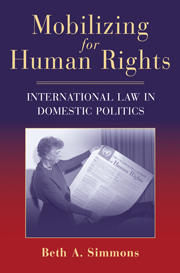Book contents
- Frontmatter
- Contents
- List of Figures and Tables
- Acknowledgments
- Abbreviations
- Part I
- 1 Introduction
- 2 Why International Law? The Development of the International Human Rights Regime in the Twentieth Century
- 3 Theories of Commitment
- 4 Theories of Compliance
- Part II
- Appendix 1 Data Appendix
- Appendix 2 Regime Type and Rule of Law Categories
- References
- Index
2 - Why International Law? The Development of the International Human Rights Regime in the Twentieth Century
Published online by Cambridge University Press: 05 June 2012
- Frontmatter
- Contents
- List of Figures and Tables
- Acknowledgments
- Abbreviations
- Part I
- 1 Introduction
- 2 Why International Law? The Development of the International Human Rights Regime in the Twentieth Century
- 3 Theories of Commitment
- 4 Theories of Compliance
- Part II
- Appendix 1 Data Appendix
- Appendix 2 Regime Type and Rule of Law Categories
- References
- Index
Summary
It is difficult to restrain myself from doing something to stop this attempt to exterminate a race, but I realize I am here as an Ambassador and must abide by the principles of non-interference with the internal affairs of another country.
Henry Morgenthau, U.S. ambassador in Turkey, to the U.S. secretary of state 11 August 1915The second half of the twentieth century was the first time in history that human rights were addressed in a systematic manner by the international community. Following the Second World War, official as well as nonstate actors worked together to address a broad range of rights – civil and political, economic and social, rights of nondiscrimination – and to finalize many of these in the form of legally binding covenants. The international legal edifice that thousands worked to shape has attracted criticism as well as praise; it has raised expectations as well as overpromised; it has aspired to universality yet still reflects some of the hegemonic ideas of the most powerful actors in the world polity. Most importantly, though, it has successfully challenged the unconditional assertion of national leaders that the way they treat their own people is exclusively a national sovereign concern. The idea that a government should have the freedom to treat its people as brutally as it wishes while others are helpless to intervene because of its status as a sovereign state is legally – and possibly, morally – untenable in the twenty-first century.
- Type
- Chapter
- Information
- Mobilizing for Human RightsInternational Law in Domestic Politics, pp. 23 - 56Publisher: Cambridge University PressPrint publication year: 2009



